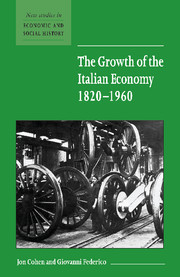Book contents
- Frontmatter
- Contents
- List of figures
- List of tables
- Acknowledgements
- 1 Introduction
- 2 Measuring change in the long run: the data
- 3 The big picture: models of growth and structural change
- 4 Modernization versus tradition: new views and old on agriculture
- 5 Against all odds? The growth of industry and services
- 6 Macroeconomic policy, institutions, and the balance of payments
- 7 An economic miracle? Italy in the Golden Age, 1945–1960
- 8 Conclusion
- Bibliography
- Index
- New Studies in Economic and Social History
- Previously published as Studies in Economic and Social History
- Economic History Society
7 - An economic miracle? Italy in the Golden Age, 1945–1960
Published online by Cambridge University Press: 05 June 2012
- Frontmatter
- Contents
- List of figures
- List of tables
- Acknowledgements
- 1 Introduction
- 2 Measuring change in the long run: the data
- 3 The big picture: models of growth and structural change
- 4 Modernization versus tradition: new views and old on agriculture
- 5 Against all odds? The growth of industry and services
- 6 Macroeconomic policy, institutions, and the balance of payments
- 7 An economic miracle? Italy in the Golden Age, 1945–1960
- 8 Conclusion
- Bibliography
- Index
- New Studies in Economic and Social History
- Previously published as Studies in Economic and Social History
- Economic History Society
Summary
7.1 Economic growth, more than any other feature, denned this period and shaped the literature. The reasons for this are easy to understand. Rates of growth of GDP, GDP per capita, total factor productivity, and output per worker were higher and more sustained than at any time in the country's history. It was as if, almost a century after unification, domestic and international economic conditions conspired to release the country's considerable economic potential.
The growth, moreover, was associated with dramatic structural change. In 1950, agriculture was still the dominant sector, accounting for over 40 per cent of total employment and 25 per cent of value added. By the early 1960s, agriculture no longer dominated the Italian economy – in terms of both employment and value added, industry and services were larger. As a result, Italy finally joined the league of industrial nations - and never looked back. Agriculture during this period was itself transformed. Output grew rapidly but, of greater importance, the growth of labour productivity was even larger so that the sector released labour even as its output expanded.
As Petri (1997a, p. 368) and others observe, inflation remained modest, certainly by Italian standards, throughout the period of rapid growth. This was the result of a conscious attempt by the Bank of Italy to moderate increases in the money supply and by the government to rein in budget deficits.
Rates of investment and saving were the highest in the history of modern Italy.
- Type
- Chapter
- Information
- The Growth of the Italian Economy, 1820–1960 , pp. 87 - 106Publisher: Cambridge University PressPrint publication year: 2001



